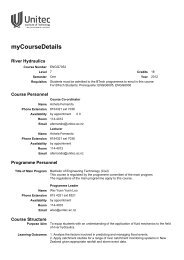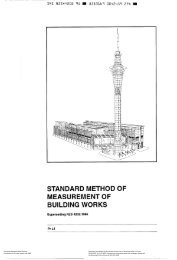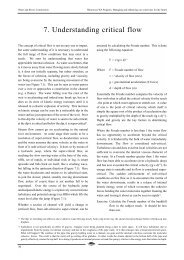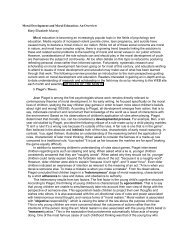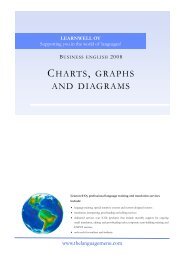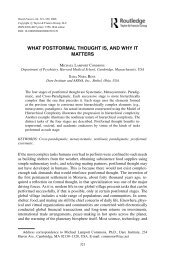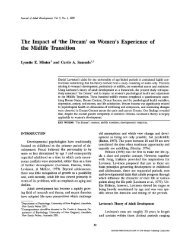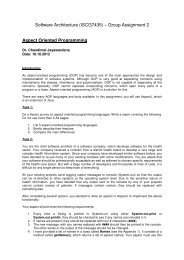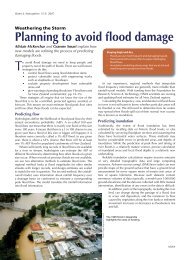promoting self awareness in nurses to improve nursing practice.pdf
promoting self awareness in nurses to improve nursing practice.pdf
promoting self awareness in nurses to improve nursing practice.pdf
Create successful ePaper yourself
Turn your PDF publications into a flip-book with our unique Google optimized e-Paper software.
leam<strong>in</strong>gzone<br />
CONTINUING PROFESSIONAL OEVELOPMENT<br />
Page 54<br />
Self-<strong>awareness</strong> multiple<br />
cboice questionnaire<br />
Page 55<br />
Read Jennifer Armitage's<br />
<strong>practice</strong> profile on<br />
<strong>in</strong>sul<strong>in</strong> therapy<br />
Page 56<br />
Guidel<strong>in</strong>es on how <strong>to</strong><br />
write a <strong>practice</strong> profile<br />
Promot<strong>in</strong>g <strong>self</strong>-<strong>awareness</strong> <strong>in</strong> <strong>nurses</strong><br />
<strong>to</strong> <strong>improve</strong> nurs<strong>in</strong>g <strong>practice</strong><br />
NS388 Jack K, Smith A (2007) Promot<strong>in</strong>g <strong>self</strong>-<strong>awareness</strong> <strong>in</strong> <strong>nurses</strong> <strong>to</strong> <strong>improve</strong> nurs<strong>in</strong>g <strong>practice</strong>.<br />
Nurs<strong>in</strong>g Standard. 21, 32, 47-52. Date of acceptance: March 8 2007<br />
Surnniary<br />
This article expiores the concept of <strong>self</strong>-<strong>awareness</strong> and describes<br />
how it can be bénéficiai <strong>to</strong> <strong>nurses</strong> on a personai and professional<br />
levei. Practicai <strong>to</strong>ois such as the Johari W<strong>in</strong>dow are presented <strong>to</strong><br />
assist the reader <strong>in</strong> this process. The authors discuss portfolio<br />
development, which provides the opportunity <strong>to</strong> document personai<br />
and professional growth.<br />
Authors<br />
Kirsten Jaci< is senior lecturer <strong>in</strong> adult nurs<strong>in</strong>g, Manchester<br />
iVletropoiitan University; Anne Smith is direc<strong>to</strong>r of nurs<strong>in</strong>g studies,<br />
University of Read<strong>in</strong>g, Read<strong>in</strong>g. Emaii: i
learn<strong>in</strong>g zone professional issues<br />
At times, emotions may take over and we can<br />
feel as though we are be<strong>in</strong>g swept away, Goleman<br />
(1995) suggests the <strong>self</strong>-aware person is able <strong>to</strong><br />
manage his or her feel<strong>in</strong>gs and emotions and stay<br />
<strong>in</strong> charge, rather than be overwhelmed by them,<br />
Menzies ( 1970) describes the way that <strong>nurses</strong><br />
attempt <strong>to</strong> manage the stress and emotion that<br />
often accompanies car<strong>in</strong>g by detachment and<br />
compartmentalis<strong>in</strong>g patient care, so that they<br />
ma<strong>in</strong>ta<strong>in</strong> control rather than becom<strong>in</strong>g<br />
emotionally unable <strong>to</strong> cope. That is not <strong>to</strong> say<br />
that, as <strong>nurses</strong>, we should not feel any emotion at<br />
all. However, knowledge of how certa<strong>in</strong><br />
situations can make us feel affords us the<br />
opportunity <strong>to</strong> plan ahead and prepare.<br />
Therefore, rather than avoid dy<strong>in</strong>g patients, the<br />
nurse should develop appropriate cop<strong>in</strong>g skills<br />
when support<strong>in</strong>g the patient and his or her family.<br />
Reflect on an occasion <strong>in</strong> <strong>practice</strong> when your feel<strong>in</strong>gs<br />
! may have <strong>in</strong>fluenced your thoughts and behaviour. Did you~<br />
I feel <strong>in</strong> control of the situation? Did your emotions affect your<br />
i level of confidence <strong>in</strong> this situation or how you perceived<br />
I others? Emotions can prompt action and <strong>in</strong>action, <strong>in</strong>tervention<br />
and withdrawal. Write your thoughts down or discuss this<br />
I occasion with a friend.<br />
Discovery of the <strong>self</strong> is an ongo<strong>in</strong>g, cont<strong>in</strong>uous<br />
process which, at times, can be pa<strong>in</strong>ful as hidden<br />
aspects are slowly uncovered. When confronted<br />
with difficult situations <strong>in</strong> the work<strong>in</strong>g<br />
environment, we are expected <strong>to</strong> behave<br />
professionally, although feel<strong>in</strong>gs of vulnerability<br />
and uncerta<strong>in</strong>ty may challenge our perceived<br />
abilities. Be<strong>in</strong>g more <strong>self</strong>-aware can help us <strong>to</strong><br />
cope <strong>in</strong> such circumstances, help<strong>in</strong>g us <strong>to</strong> respect<br />
our anxieties and concerns and prompt<strong>in</strong>g<br />
questions about how these could be overcome.<br />
Self-<strong>awareness</strong> can help us present ourselves<br />
more appropriately <strong>in</strong> the therapeutic<br />
relationship (Sundeen et al 1998). It <strong>in</strong>volves<br />
recognis<strong>in</strong>g what we know, what skills we employ<br />
and what limitations affect our ability <strong>to</strong><br />
<strong>in</strong>tervene. It can also enable us <strong>to</strong> present<br />
ourselves as knowledgeable, expert <strong>in</strong> some<br />
areas and as still learn<strong>in</strong>g but supportive <strong>in</strong><br />
others. It is necessary <strong>to</strong> question the effect we<br />
have on others <strong>in</strong> the car<strong>in</strong>g environment<br />
(Hoffman 2001). Certa<strong>in</strong>ly, the <strong>self</strong> can be used<br />
therapeutically <strong>to</strong> develop the patient's trust<br />
and <strong>to</strong> promote a sense of wellbe<strong>in</strong>g (McCabe<br />
2000). By <strong>in</strong>creas<strong>in</strong>g our <strong>self</strong>-<strong>awareness</strong>, we<br />
can be more effective <strong>in</strong> our personal and<br />
professional lives.<br />
Comnn<strong>in</strong>ication and car<strong>in</strong>g<br />
^^^<br />
Communication skills are essential <strong>in</strong> the car<strong>in</strong>g<br />
relationship and are an important aspect of nurse<br />
education (Nurs<strong>in</strong>g and Midwifery Council (NMC)<br />
2005). The need for effective skills is emphasised<br />
by the Department of Health (DH) (2006) <strong>in</strong> its<br />
proposals for reform. The four ma<strong>in</strong> goals set out<br />
focus on: prevent<strong>in</strong>g ill health, <strong>promot<strong>in</strong>g</strong> more<br />
patient choice, reduc<strong>in</strong>g <strong>in</strong>equalities and support<strong>in</strong>g<br />
patients with long-term needs. The aims will not be<br />
realised without effective communication skills,<br />
which enable us <strong>to</strong> gather and give <strong>in</strong>formation,<br />
expla<strong>in</strong> <strong>in</strong>tentions and actions and use ourselves<br />
<strong>in</strong> a therapeutic manner. The ability <strong>to</strong> do this<br />
may be enhanced by a greater level of <strong>self</strong><strong>awareness</strong><br />
(Rowe 1999).<br />
Generally, communication beg<strong>in</strong>s with nonverbal<br />
cues and the <strong>to</strong>ne of the voice or <strong>in</strong>flection<br />
used can be more <strong>in</strong>fluential than the words spoken.<br />
If we are unaware of our body language by, for<br />
example, present<strong>in</strong>g a closed posture, or not mak<strong>in</strong>g<br />
eye contact, this could have a negative impact or<br />
change the message received by the patient. Ways of<br />
overcom<strong>in</strong>g this can be learned, and conscious<br />
recognition of how our <strong>in</strong>itial presentation will<br />
affect the ongo<strong>in</strong>g communication should be<br />
considered. Conscious <strong>in</strong>tegration of theories,<br />
such as that described by Egan (1998), could<br />
<strong>in</strong>fluence the communication process <strong>in</strong> a more<br />
therapeutic way. At first, <strong>in</strong>tegration of theory <strong>in</strong><strong>to</strong><br />
communication may seem false - almost like<br />
act<strong>in</strong>g; however, as with all skills, the more these<br />
are practised the more accomplished we become,<br />
Egan (1998) uses the acronym SOLER <strong>to</strong><br />
describe the body language that could be<br />
consciously considered (Box 1).<br />
Consider two or three conversations<br />
that you have over the next week with<br />
different people, for example, your partner,<br />
a patient or a colleague. Consider your use of<br />
body language with the different people you<br />
meet. This exercise will help you <strong>to</strong> th<strong>in</strong>k about<br />
the aspects of body language that are more or<br />
less effective <strong>in</strong> different situations. For<br />
example, do you fiddle with a pen or item of<br />
jewellery when speak<strong>in</strong>g? Do you use your<br />
hands <strong>to</strong> get your message across? Could this<br />
distract others?<br />
Application of Egan's model can help us <strong>to</strong> look<br />
attentive and take <strong>in</strong> what a patient is say<strong>in</strong>g. This<br />
can encourage patients <strong>to</strong> disclose issues that they<br />
may normally f<strong>in</strong>d difficult <strong>to</strong> discuss. Patients<br />
seek <strong>to</strong> trust <strong>nurses</strong> as professionals and are<br />
sensitive <strong>to</strong> cues they receive through the <strong>to</strong>ne<br />
of voice and other paral<strong>in</strong>guistic behaviour.<br />
48 april 18 :: vol 21 no 32 :: 2007 NURSING STANDARD
Egan's model<br />
• Sit squarely<br />
• Open posture<br />
• Lean forward<br />
* Eye contact<br />
• Relaxed and unhurried appearance<br />
(Egan 1998)<br />
However, there may be times when we are<br />
allow<strong>in</strong>g our own thoughts and feel<strong>in</strong>gs <strong>to</strong><br />
<strong>in</strong>terfere with our understand<strong>in</strong>g of what the<br />
patient is say<strong>in</strong>g (Rungapadiachy 1999).<br />
If we are go<strong>in</strong>g <strong>to</strong> ga<strong>in</strong> a deep understand<strong>in</strong>g of<br />
what a patient is tell<strong>in</strong>g us then we need <strong>to</strong> listen<br />
<strong>to</strong> what they are say<strong>in</strong>g and observe how they are<br />
say<strong>in</strong>g it and what body language is be<strong>in</strong>g used.<br />
Morrison and Burnard (1997) suggest that there<br />
are three levels of listen<strong>in</strong>g. These range from the<br />
superficial - when we are not fully listen<strong>in</strong>g and<br />
may have other th<strong>in</strong>gs on our m<strong>in</strong>d - <strong>to</strong> the<br />
deepest level - when we truly feel that we can fully<br />
acknowledge the patient's position. They refer <strong>to</strong><br />
this as'resonance'.<br />
Reflect on two <strong>to</strong> three conversations<br />
that you have had with patients recently.^<br />
; Were you aware of how attentively you were<br />
listen<strong>in</strong>g <strong>to</strong> what was be<strong>in</strong>g said? Were you<br />
listen<strong>in</strong>g on a superficial or deeper level? Do<br />
I you th<strong>in</strong>k that your listen<strong>in</strong>g style may have |<br />
put the patient off open<strong>in</strong>g up more fully <strong>to</strong><br />
you? Were you engag<strong>in</strong>g with the patient and<br />
reflect<strong>in</strong>g their emotions or concerns, that is, j<br />
listen<strong>in</strong>g at a deeper level?<br />
It can sometimes be easier <strong>to</strong> act as if you are<br />
busy rather than engage with a patient <strong>in</strong> a<br />
conversation. This is a natural way <strong>to</strong> behave and<br />
is used as a form of defence aga<strong>in</strong>st the potential<br />
stra<strong>in</strong> of nurs<strong>in</strong>g work (Menzies 1970). As <strong>nurses</strong><br />
it is not easy <strong>to</strong> predict what the patient wants <strong>to</strong><br />
discuss, and the conversation may stray <strong>in</strong><strong>to</strong><br />
terri<strong>to</strong>ry with which we feel uncomfortable. It is<br />
not surpris<strong>in</strong>g that we may f<strong>in</strong>d it difficult <strong>to</strong> deal<br />
with patients' feel<strong>in</strong>gs and block communication<br />
when they start <strong>to</strong> share their feel<strong>in</strong>gs with us<br />
(Booth etal 1996). If we do not know our own<br />
<strong>self</strong>, we are more likely <strong>to</strong> feel vulnerable when<br />
patients express themselves (Jourard 1971).<br />
Therefore, by develop<strong>in</strong>g skills of <strong>self</strong>-<strong>awareness</strong>,<br />
we may be able <strong>to</strong> respond <strong>in</strong> a more appropriate<br />
way, thus help<strong>in</strong>g the patient and sav<strong>in</strong>g personal<br />
feel<strong>in</strong>gs of embarrassment.<br />
Heron's (1990) six category <strong>in</strong>tervention<br />
analysis is a useful framework for exam<strong>in</strong><strong>in</strong>g our<br />
perceptions about how we communicate with<br />
patients (Box2).<br />
An exam<strong>in</strong>ation of <strong>nurses</strong>' <strong>in</strong>terpersonal skills<br />
was undertaken by Burnard and Morrison<br />
(2005). The authors found that <strong>nurses</strong> felt less<br />
skilled <strong>in</strong> facilitative <strong>in</strong>terventions and more<br />
skilled <strong>in</strong> authoritative ones, although there were<br />
some exceptions.<br />
Draw<strong>in</strong>g on your own experiences, which categories<br />
do you feel more or less skilled <strong>in</strong>? What <strong>in</strong>fluences your<br />
use of the different types of <strong>in</strong>tervention? For example, you<br />
may feel less skilled <strong>in</strong> the cathartic style of <strong>in</strong>tervention. How<br />
can you develop the skills needed, and what support do you<br />
need when patients release fear or anger?<br />
What has been described is the way <strong>in</strong> which<br />
<strong>self</strong>-<strong>awareness</strong> can be beneficial when car<strong>in</strong>g for<br />
and communicat<strong>in</strong>g with patients. However, the<br />
development of <strong>self</strong>-<strong>awareness</strong> is also important<br />
for our own wellbe<strong>in</strong>g (Freshwater 2002). Be<strong>in</strong>g<br />
more <strong>self</strong>-aware helps us <strong>to</strong> take control of<br />
situations and become less of a victim. Burnard<br />
(1992) describes this as becom<strong>in</strong>g less 'acted<br />
upon'. Becom<strong>in</strong>g more aware of our environment<br />
and what may cause us anxiety enables us <strong>to</strong> plan<br />
ahead and organise our lives <strong>to</strong> prevent situations<br />
gett<strong>in</strong>g out of control.<br />
For example, the thought of giv<strong>in</strong>g a<br />
presentation <strong>to</strong> a group of people may <strong>in</strong>voke fear<br />
and anxiety that can be so profound that the<br />
presenter is unable <strong>to</strong> speak and becomes<br />
disabled. Of course, by merely be<strong>in</strong>g aware of the<br />
issues, the presenter will not suddenly become<br />
more relaxed about present<strong>in</strong>g - this requires a<br />
certa<strong>in</strong> amount of forward plann<strong>in</strong>g. Plans could<br />
<strong>in</strong>clude breath<strong>in</strong>g exercises or th<strong>in</strong>k<strong>in</strong>g of a<br />
trigger which will <strong>in</strong>itiate a more calm and<br />
resourceful state, a technique referred <strong>to</strong> as<br />
Six category <strong>in</strong>tervention analysis<br />
Authoritative categories<br />
Prescriptive <strong>in</strong>terventions<br />
Direct behaviour by offer<strong>in</strong>g advice.<br />
Informative <strong>in</strong>terventions<br />
Offer and impart <strong>in</strong>formation.<br />
Confront<strong>in</strong>g <strong>in</strong>terventions<br />
Confront patients about a limit<strong>in</strong>g<br />
attitude or behaviour of which they<br />
may be unaware.<br />
(Heron 1990)<br />
Facilitative categories<br />
Cathartic <strong>in</strong>terventions<br />
Enable the patient <strong>to</strong> release<br />
emotions, such as anger or grief.<br />
Catalytic <strong>in</strong>terventions<br />
Attempt <strong>to</strong> draw out <strong>self</strong>-discovery<br />
and promote problem-solv<strong>in</strong>g<br />
<strong>in</strong> patients.<br />
Supportive <strong>in</strong>terventions<br />
Encourage and affirm patients'<br />
qualities and actions.<br />
NURSING STANDARD april 18 :: vol 21 no 32 :; 2007 49
learn<strong>in</strong>g zone professional issues<br />
anchor<strong>in</strong>g (McLeod 2003 ). It may also <strong>in</strong>volve<br />
enlist<strong>in</strong>g the help of others who can help <strong>to</strong><br />
evaluate the performance by giv<strong>in</strong>g critical,<br />
constructive feedback.<br />
about our hidden selves and the more we learn<br />
about our bl<strong>in</strong>d area, the more our unknown area<br />
will shr<strong>in</strong>k. This process helps us <strong>to</strong> develop a<br />
greater understand<strong>in</strong>g of ourselves and others. It<br />
<strong>in</strong>volves an element of risk, s<strong>in</strong>ce we have <strong>to</strong><br />
disclose someth<strong>in</strong>g of ourselves and be prepared<br />
<strong>to</strong> receive feedback from others.<br />
Th<strong>in</strong>k about aspects of your life that may cause you<br />
; anxiety. It may be, for example, that you have an <strong>in</strong>terview^<br />
or an important meet<strong>in</strong>g com<strong>in</strong>g up. Th<strong>in</strong>k about the strategies<br />
or education that you need <strong>to</strong> support you. You may need <strong>to</strong><br />
enlist the help of someone else or consider a role model that you<br />
have met. Th<strong>in</strong>k about and learn from the way that they would<br />
; deal with this situation. By be<strong>in</strong>g <strong>self</strong>-aware we are more able <strong>to</strong><br />
become a role model <strong>to</strong> others.<br />
Understand<strong>in</strong>g ourselves well enough <strong>to</strong> know<br />
what can make us anxious and less resourceful<br />
helps us <strong>to</strong> take action <strong>to</strong> <strong>improve</strong> our situation.<br />
Therefore, rather than becom<strong>in</strong>g overcome by<br />
situations, we can act <strong>to</strong> <strong>improve</strong> the outcome.<br />
Develop<strong>in</strong>g <strong>self</strong>-<strong>awareness</strong><br />
Self-<strong>awareness</strong> should not be viewed as a state that<br />
we can atta<strong>in</strong> completely - it is a constant voyage of<br />
discovery tbat is never complete (Burnard 1988).<br />
Rungapadiachy (1999) states that the nature of<br />
be<strong>in</strong>g <strong>self</strong>-aware means there is no 'saturation<br />
po<strong>in</strong>t'. He proposes three layers of <strong>self</strong>-<strong>awareness</strong>.<br />
First is superficial, for example, <strong>awareness</strong> of one's<br />
age and gender. Second is selective, which <strong>in</strong>cludes<br />
<strong>awareness</strong> of th<strong>in</strong>gs that we feel we may need <strong>to</strong> be<br />
aware of, such as our outward appearance and<br />
attitudes. Third is deeper <strong>awareness</strong> - issues<br />
known only <strong>to</strong> ourselves. This level reflects our<br />
deepest secrets and thoughts.<br />
One way of explor<strong>in</strong>g these ideas is by th<strong>in</strong>k<strong>in</strong>g<br />
about the Johari W<strong>in</strong>dow (Luft 1969) (Figure 1 ).<br />
This is a model that can be used <strong>to</strong> explore aspects<br />
of ourselves and consists of four quadrants:<br />
• Open.<br />
• Bl<strong>in</strong>d.<br />
• Hidden.<br />
• Unknown.<br />
50 april 18 :: vol 21 no 32 :: 2007<br />
The open area is the area that we know about<br />
ourselves and is also known <strong>to</strong> others. The bl<strong>in</strong>d<br />
area <strong>in</strong>cludes the th<strong>in</strong>gs that others know but we<br />
do not. The hidden area <strong>in</strong>cludes th<strong>in</strong>gs we know<br />
about ourselves but do not reveal <strong>to</strong> others. The<br />
unknown area is unknown <strong>to</strong> both us and others.<br />
As we learn more about ourselves the quadrants<br />
will change <strong>in</strong> size. The more we reveal <strong>to</strong> others<br />
\ Exam<strong>in</strong>e the Johari W<strong>in</strong>dow (Figure 1)<br />
and then draw one for your<strong>self</strong>. Make<br />
notes <strong>in</strong> each of the sections.<br />
• Open area: What is known <strong>to</strong> me and also<br />
<strong>to</strong> others? This could <strong>in</strong>clude feel<strong>in</strong>gs,<br />
attitudes and behaviours, likes and dislikes.<br />
• Bl<strong>in</strong>d area: This may be more difficult but try<br />
<strong>to</strong> imag<strong>in</strong>e how others see you. This could<br />
<strong>in</strong>clude your friends, colleagues at work or<br />
a patient. They may th<strong>in</strong>k you have certa<strong>in</strong><br />
mannerisms of which you are not conscious.<br />
• Hidden area: What do you know about<br />
your<strong>self</strong> but would not disclose <strong>to</strong> others?<br />
• Unknown area: This may be challeng<strong>in</strong>g<br />
s<strong>in</strong>ce this is the part that is unknown <strong>to</strong> you<br />
and others. Delve beneath the surface and<br />
consider what you are really like. This may<br />
be a different <strong>self</strong> <strong>to</strong> the one you present<br />
both <strong>to</strong> others and your<strong>self</strong>. This is the area<br />
that will change as you develop new skills [<br />
and new knowledge. |<br />
Reflect on what you have written. Did it i<br />
surprise you <strong>in</strong> any way? Could you do this I<br />
exercise with someone else <strong>to</strong> learn more [<br />
about what others th<strong>in</strong>k of you?<br />
Palmer eííj/(1994) warn that exam<strong>in</strong>ation of<br />
ourselves does <strong>in</strong>volve risk as we are never sure<br />
what we may f<strong>in</strong>d. They state that this can be<br />
powerful <strong>in</strong> identify<strong>in</strong>g characteristics of which we<br />
may be unaware but which are pa<strong>in</strong>ful. They also<br />
exam<strong>in</strong>e the fact that most <strong>in</strong>dividuals base their<br />
concept of themselves on other people's<br />
perceptions, which may not be accurate. This<br />
causes further disorientation. However, the<br />
benefits should be a much enhanced sense of <strong>self</strong><br />
and a further sense of openness <strong>to</strong> new experiences.<br />
Reflective <strong>practice</strong><br />
Becom<strong>in</strong>g <strong>self</strong>-aware is an ongo<strong>in</strong>g process that is<br />
never complete. Therefore, <strong>self</strong>-evaluation needs<br />
<strong>to</strong> be undertaken at regular <strong>in</strong>tervals. This<br />
evaluation process helps us <strong>to</strong> see how far we have<br />
come, identify what we still need <strong>to</strong> learn and plan<br />
how we are go<strong>in</strong>g <strong>to</strong> get there (Burnard 1988). One<br />
way <strong>to</strong> <strong>self</strong>-evaluate may be through a reflective<br />
diary which will be discussed later.<br />
In nurs<strong>in</strong>g, reflection is a commonly used term<br />
but is not necessarily an activity performed<br />
NURSING STANDARD
effectively. Reflection may be associated with a<br />
certa<strong>in</strong> amount of stress; however, it does have the<br />
potential <strong>to</strong> <strong>in</strong>crease <strong>self</strong>-<strong>awareness</strong> (Newell<br />
1992). Reflective <strong>practice</strong> helps us <strong>to</strong> exam<strong>in</strong>e our<br />
thoughts and feel<strong>in</strong>gs - not only our reactions <strong>to</strong><br />
these but also the effect they may have on others<br />
(Smith 1995).<br />
To help <strong>nurses</strong> reflect, certa<strong>in</strong> models can<br />
provide a framework or an aide-mémoire, for<br />
example, Gibbs' (1988) cycle. In this <strong>in</strong>stance you<br />
are asked <strong>to</strong> consider your feel<strong>in</strong>gs as part of the<br />
cycle. Once the scenario has been described the<br />
next part of the cycle asks you <strong>to</strong> consider your<br />
feel<strong>in</strong>gs about it, consider<strong>in</strong>g what it was that<br />
caused you <strong>to</strong> reflect on this and your personal<br />
perception and response, whether good or bad.<br />
This acknowledges that often reflection is<br />
triggered by some uncomfortable feel<strong>in</strong>gs or,<br />
conversely, by feel<strong>in</strong>g that th<strong>in</strong>gs went well.<br />
Boudeffl/(1985) recognised the centrality of<br />
our feel<strong>in</strong>gs <strong>to</strong> everyth<strong>in</strong>g that we do and how we<br />
reflect regularly on our behaviour whatever the<br />
context. They refer <strong>to</strong> the cathartic elements of<br />
reflection, just as Heron (1990) identified. They<br />
recognise that it is vital for us <strong>to</strong> be <strong>in</strong> <strong>to</strong>uch with<br />
our emotions and feel<strong>in</strong>gs and <strong>to</strong> have an outlet<br />
for negative and irrational thoughts. This<br />
promotes a heightened level of <strong>self</strong>-<strong>awareness</strong> and<br />
deeper <strong>self</strong>- knowledge. It is only when we have<br />
explored our own feel<strong>in</strong>gs that we can help others<br />
(Burnard 1992).<br />
Heron (1990) also po<strong>in</strong>ts out that it is vital <strong>to</strong><br />
be able <strong>to</strong> discharge or transform any barriers so<br />
that it is possible <strong>to</strong> move forward. You may have<br />
identified issues <strong>in</strong> your own life that affect your<br />
performance and may <strong>in</strong>hibit your ability. Boud et<br />
al (1985) discuss the way that new knowledge<br />
may become so related <strong>to</strong> the <strong>self</strong> that it enters our<br />
identity and changes our world view. They call<br />
this appropriation. So when people say an<br />
experience has changed their lives, they are<br />
demonstrat<strong>in</strong>g that they were open <strong>to</strong> such a<br />
possibility and recognised it was happen<strong>in</strong>g as<br />
they were <strong>self</strong>-aware enough <strong>to</strong> perceive it.<br />
Portfolios^<br />
Portfolios have become an accepted way for<br />
<strong>nurses</strong> <strong>to</strong> demonstrate their learn<strong>in</strong>g. A portfolio<br />
is a useful document for supply<strong>in</strong>g evidence of<br />
achievements and of lifelong learn<strong>in</strong>g. It can be<br />
<strong>in</strong>dividualised and compiled creatively <strong>to</strong><br />
illustrate skills and competencies across a wide<br />
spectrum of experiences. This can capture the<br />
essence of nurs<strong>in</strong>g <strong>in</strong> a variety of ways and<br />
provide a shop w<strong>in</strong>dow <strong>to</strong> display a range of<br />
talents. For example, <strong>in</strong>formation technology<br />
accomplishments may range from basic computer<br />
skills <strong>to</strong> more advanced skills <strong>in</strong> the use of<br />
<strong>in</strong>formation and communication technology.<br />
Reflective accounts are normally <strong>in</strong>cluded.<br />
Actually compil<strong>in</strong>g the portfolio can <strong>in</strong> it<strong>self</strong><br />
stimulate reflection and challenge <strong>practice</strong> (Hull<br />
and Redfern 1996). When you are develop<strong>in</strong>g<br />
your portfolio it will be a unique record of your<br />
work<strong>in</strong>g and personal life.<br />
Keep<strong>in</strong>g reflective accounts <strong>in</strong> a diary enables<br />
you <strong>to</strong> chart and record your progress or areas<br />
need<strong>in</strong>g further development. Boud eifl/( 1985)<br />
proposed useful practical tips <strong>to</strong> aid diary writ<strong>in</strong>g.<br />
These have been adapted for a more<br />
contemporary audience:<br />
• Be honest. Write it as it is, not as it should or<br />
might have been.<br />
• Have a positive approach rather than just<br />
be<strong>in</strong>g critical.<br />
• Be spontaneous. Do not spend <strong>to</strong>o long on<br />
decid<strong>in</strong>g how <strong>to</strong> write it.<br />
• Express your<strong>self</strong> <strong>in</strong> any way that is mean<strong>in</strong>gful<br />
<strong>to</strong> you, such as with diagrams or shorthand. It<br />
does not have <strong>to</strong> be written <strong>in</strong> a l<strong>in</strong>ear fashion.<br />
• This is your personal workbook so you can<br />
add, underl<strong>in</strong>e, circle or doodle as you wish <strong>to</strong><br />
aid your recall.<br />
FIGURE 1<br />
Johari W<strong>in</strong>dow<br />
Known <strong>to</strong> others<br />
Not known<br />
<strong>to</strong> others<br />
(Luft 1969)<br />
WÊÊÊÊÊÊÊÊÊÊÊÊ^gÊÊ^^^^^^M<br />
Known <strong>to</strong> <strong>self</strong><br />
Open area<br />
Example: This is what I<br />
know about my<strong>self</strong> and<br />
what others know about<br />
me, for example, I am<br />
female and easy go<strong>in</strong>g.<br />
Hidden area<br />
Example: This is what I<br />
know about my<strong>self</strong> but<br />
hide from others. I may<br />
hide more or iess from<br />
different people. My<br />
family may know more of<br />
this hidden area than my<br />
work colleagues. The<br />
more I disclose from this<br />
area, the bigger my open<br />
area will become and the<br />
more I may learn about<br />
my<strong>self</strong> <strong>in</strong> the process. For<br />
example, I may cry at<br />
sad films but do not<br />
want my work colleagues<br />
<strong>to</strong> know.<br />
Not known <strong>to</strong> <strong>self</strong><br />
Bl<strong>in</strong>d area<br />
Example: My friends may<br />
have a view of me of which<br />
I am unaware. I can uncover<br />
these views if others tell<br />
me about them. This will<br />
<strong>in</strong>crease my 'open' area. For<br />
example, my friends may<br />
th<strong>in</strong>k that I talk <strong>to</strong>o much<br />
and I may be completely<br />
unaware of this fact.<br />
Unknown area<br />
Example: The unknown<br />
area is not known <strong>to</strong><br />
ourselves or others.<br />
As we receive feedback<br />
from others and tell others<br />
more about ourselves, we<br />
can develop <strong>in</strong><strong>to</strong> this<br />
unknown area and it will<br />
shr<strong>in</strong>k <strong>in</strong> size.<br />
NURSING STANDARD april 18 :: vol 21 no 32 :: 2007 51
learn<strong>in</strong>g zone professional issues<br />
• Use the language that suits you.<br />
• Be experimental <strong>in</strong> how you keep this record.<br />
You may divide the page <strong>in</strong><strong>to</strong> sections or come<br />
back and add someth<strong>in</strong>g later.<br />
• Set time aside for this important activity and<br />
persevere.<br />
• Consider keep<strong>in</strong>g it as an e-journal, or<br />
personal blog. You could <strong>in</strong>vite your friends <strong>to</strong><br />
participate and offer feedback.<br />
Your diary can become a highly personal<br />
document and one which you may only want <strong>to</strong><br />
share with close friends and colleagues. However,<br />
by engag<strong>in</strong>g <strong>in</strong> this process <strong>in</strong> a trust<strong>in</strong>g<br />
environment, you can discuss your entries with<br />
others and receive feedback. It may be useful <strong>to</strong><br />
enlist the help of a trusted supervisor or men<strong>to</strong>r <strong>in</strong><br />
this process who may also consider shar<strong>in</strong>g their<br />
diary with the group, result<strong>in</strong>g <strong>in</strong> a more<br />
reciprocal approach (Burnard 1988). By<br />
challeng<strong>in</strong>g and discuss<strong>in</strong>g <strong>in</strong>cidents and<br />
dilemmas from <strong>practice</strong>, we can develop different<br />
ways of th<strong>in</strong>k<strong>in</strong>g about and understand<strong>in</strong>g our<br />
reactions, which leads <strong>to</strong> further development of<br />
our <strong>self</strong>-<strong>awareness</strong>. We can then apply this new<br />
knowledge <strong>to</strong> future situations (Smith 1995).<br />
Conclusion<br />
The more knowledge we have about ourselves, the<br />
easier it becomes <strong>to</strong> relate <strong>to</strong> others. This article<br />
has encouraged you <strong>to</strong> explore the benefits of<br />
becom<strong>in</strong>g more <strong>self</strong>-aware. It is hoped that by<br />
read<strong>in</strong>g and work<strong>in</strong>g through the activities, either<br />
alone or with a supportive colleague, you will<br />
discover how becom<strong>in</strong>g more <strong>self</strong>-aware can assist<br />
<strong>in</strong> your personal and professional life NS<br />
Now that you have completed the<br />
article you might like <strong>to</strong> write a <strong>practice</strong><br />
profile. Guidel<strong>in</strong>es <strong>to</strong> help you are on page 56.<br />
USEFUL RESOURCE<br />
The Consortium for Research on Emotional Intelligence<br />
<strong>in</strong> Organizations: The Emotional Competence Framework<br />
v^/ww.bus<strong>in</strong>essballs.com/emotional<strong>in</strong>telligence<br />
competencies.<strong>pdf</strong> (Last accessed: April 5 2007)<br />
This document provides useful <strong>in</strong>formation on some of<br />
the key components of seif-avi/areness.<br />
References<br />
Booth K, Maguire PM,<br />
Butterworth T, Hillier VF (199ó)<br />
Perceived professional support and<br />
the use of block<strong>in</strong>g behaviours by<br />
hospice <strong>nurses</strong>. Journal of Advanced<br />
Nurs<strong>in</strong>g. 24, 3, 522-527<br />
Boud D, Keogh R, Walker D<br />
(1985) Reflection: Turn<strong>in</strong>g<br />
Experience <strong>in</strong><strong>to</strong> Learn<strong>in</strong>g. Kogan<br />
Page, London.<br />
Burnard P (1986) Integrated<br />
<strong>self</strong>-<strong>awareness</strong> tra<strong>in</strong><strong>in</strong>g: a holistic<br />
model. Nurse Education Today. 6, 5,<br />
219-222.<br />
Burnard P (1988) Self-evaluation<br />
methods <strong>in</strong> nurse education. Nurse<br />
Education Today. 8. 4, 229-233.<br />
Burnard P (1992) Know Your<strong>self</strong>!<br />
Self Awareness Activities<br />
Nurses. Scutari, London.<br />
for<br />
Burnard P, Morrison P (2005)<br />
Nurses' perceptions of their<br />
<strong>in</strong>terpersonal skills: a descriptive<br />
study us<strong>in</strong>g six category<br />
<strong>in</strong>tervention analysis. Nurse<br />
Education Today. 25, 8, 612-617<br />
Department of Health (2006) Our<br />
Health, Our Care, Our Say: A New<br />
Direction for Community Services.<br />
The Stationery Office, London.<br />
Egan G (1998) The Skilled Helper<br />
A Problem Management Approach<br />
<strong>to</strong> Help<strong>in</strong>g. Sixth edition. Brooks<br />
Cole, Pacific Grove CA.<br />
Freshwater D (Ed) (2002)<br />
Therapeutic Nurs<strong>in</strong>g. Sage, London.<br />
Gibbs G (1988) Learn<strong>in</strong>g by Do<strong>in</strong>g:<br />
A Guide <strong>to</strong> Teach<strong>in</strong>g and Learn<strong>in</strong>g<br />
Methods. Oxford Brookes University,<br />
Oxford.<br />
Goleman D (1995) Emotional<br />
Intelligence: Why it Can Matter<br />
More than IQ. Blocmsbury, London.<br />
Heron J (1990) Help<strong>in</strong>g the Client:<br />
A Creative Practical Guide. Sage,<br />
London.<br />
Hoffman C (2001) Add<strong>in</strong>g str<strong>in</strong>gs<br />
<strong>to</strong> our bow or be<strong>in</strong>g here now?<br />
Complementary Therapies In<br />
Nurs<strong>in</strong>g and Midwifery. 7, 4,<br />
177-179.<br />
Hull C, Redfern L (1996) Profiles<br />
and Portfolios. Macmillan, London.<br />
Jourard S (1971) The Transparent<br />
Seif Lit<strong>to</strong>n, New York NY.<br />
Luft J (1969)0/'Wumon<br />
Interaction. National Press, Palo<br />
Al<strong>to</strong> CA.<br />
McCabe P (2000) Naturopathy,<br />
Night<strong>in</strong>gale, and nature cure: a<br />
convergence of <strong>in</strong>terests.<br />
Complementary Therapies <strong>in</strong><br />
Nurs<strong>in</strong>g and Midwifery. 6,1, 4-8.<br />
McLeod A (2003) Performance<br />
Coach<strong>in</strong>g: The Handbook for<br />
Managers, HR Professionals and<br />
Coaches. Crown House, Carmarthen.<br />
Menzies IEP (1970) The<br />
Function<strong>in</strong>g ofSociai Systems as a<br />
Defence Aga<strong>in</strong>st Anxiety Tavis<strong>to</strong>ck,<br />
London.<br />
Morrison P, Burnard P (1997)<br />
Car<strong>in</strong>g and Communicat<strong>in</strong>g.<br />
Macmillan, London.<br />
Newell R (1992) Anxiety, accuracy<br />
and reflection: the limits of<br />
professional development Journal<br />
of Advanced Nurs<strong>in</strong>g. 1711,<br />
1326-1333.<br />
Nurs<strong>in</strong>g and Midwifery Council<br />
(2005) Consultation on Proposais<br />
Aris<strong>in</strong>g from a Review of Fitness <strong>to</strong><br />
Practice at the Po<strong>in</strong>t of<br />
Registration. NMC, London.<br />
Palmer A, Burns S, Bulman C<br />
(Eds) (1994) Reflective Practice<br />
<strong>in</strong> Nurs<strong>in</strong>g. The Growth ofthe<br />
Professionai Practitioner.<br />
Blackwell Science, Oxford.<br />
Rawl<strong>in</strong>son JW (1990) Self<strong>awareness</strong>:<br />
conceptual <strong>in</strong>fluences,<br />
contribution <strong>to</strong> nurs<strong>in</strong>g, and<br />
approaches <strong>to</strong> atta<strong>in</strong>ment. Nurse<br />
Education Today 10, 2,111-117<br />
Rowe J (1999) Self-<strong>awareness</strong>:<br />
improv<strong>in</strong>g nurse-client <strong>in</strong>teractions.<br />
Nurs<strong>in</strong>g Standard. 14, 8, 37-40.<br />
Rungapadiachy DM (1999)<br />
Interpersonal Communication and<br />
Psychology for Health Care<br />
Professionais. Elsevier, Ed<strong>in</strong>burgh.<br />
Smith C (1995) Learn<strong>in</strong>g about<br />
your<strong>self</strong> helps patient care: us<strong>in</strong>g<br />
<strong>self</strong>-<strong>awareness</strong> <strong>to</strong> <strong>improve</strong> <strong>practice</strong>.<br />
Professionai Nurse. 10,6,390-392.<br />
Sundeen S, Stuart G, Ranic<strong>in</strong><br />
EAD, Cohen S (1998) Nurse-client<br />
Interaction: Impiement<strong>in</strong>g the<br />
Nurs<strong>in</strong>g Process. Mosby, St Louis MO.<br />
52 april 18 :: vol 21 no 32 :: 2007 NURSING STANDARD
Copyright of Nurs<strong>in</strong>g Standard is the property of RCN Publish<strong>in</strong>g Company and its content may not be copied<br />
or emailed <strong>to</strong> multiple sites or posted <strong>to</strong> a listserv without the copyright holder's express written permission.<br />
However, users may pr<strong>in</strong>t, download, or email articles for <strong>in</strong>dividual use.



